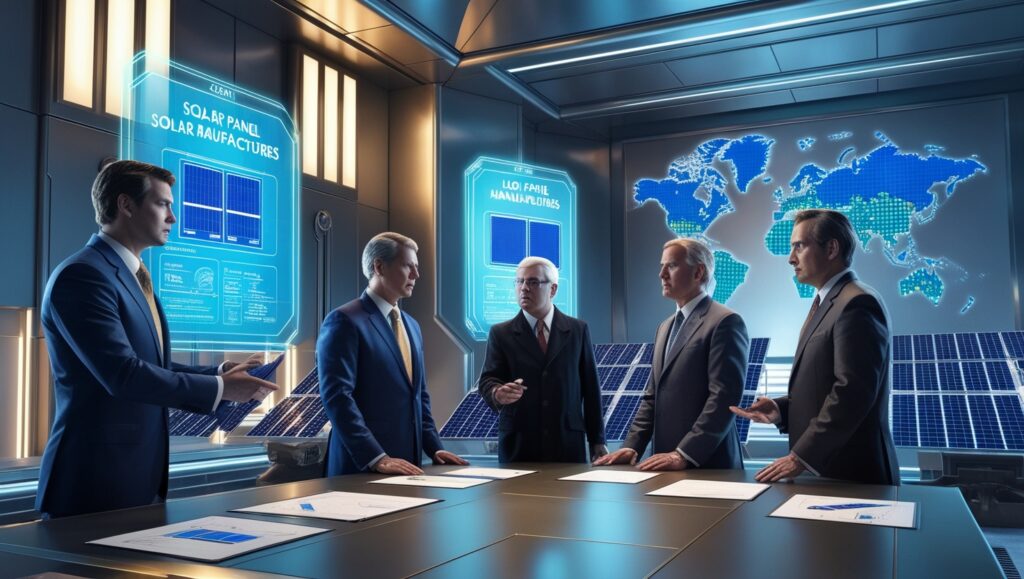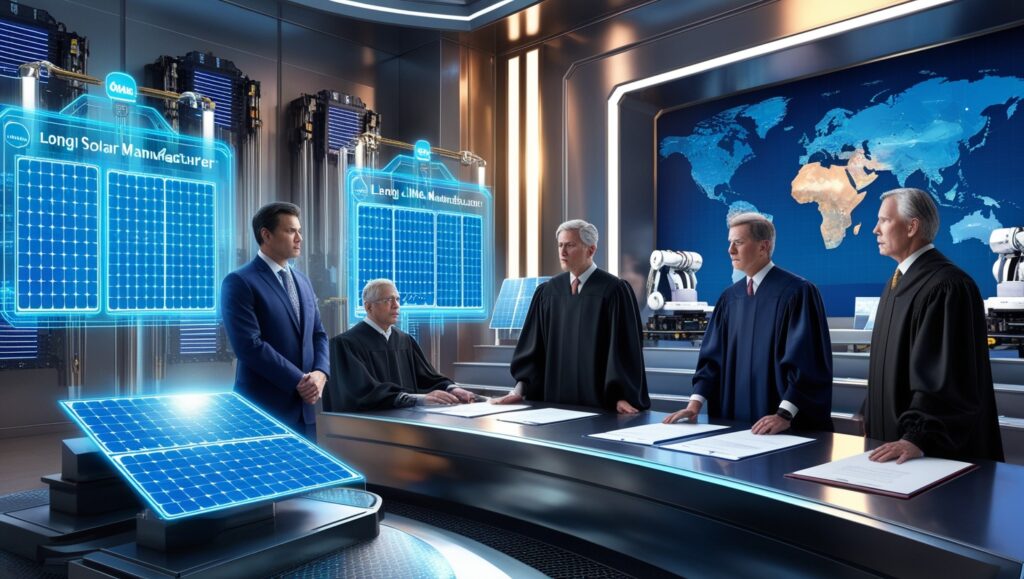The Ongoing Legal Battle in the Solar Industry
The global solar energy market has witnessed unprecedented growth, fueled by cutting-edge technological advancements and an increasing demand for clean energy solutions. However, with innovation comes intense competition, and the industry has become a battleground for intellectual property rights.
Recently, three major solar manufacturers—LONGi Green Energy Technology, JinkoSolar, and Waaree—have been accused of patent infringement, drawing attention to the complex landscape of solar technology ownership. These allegations claim that the companies unlawfully utilized proprietary photovoltaic (PV) technologies developed by other firms, potentially violating patents related to solar panel efficiency, manufacturing processes, and bifacial technology.

Why Are Patent Disputes on the Rise in the Solar Industry?
- Technological Innovation: The race to develop more efficient and cost-effective solar panels has led to overlapping research efforts, increasing the likelihood of patent conflicts.
- Market Expansion: As solar energy adoption expands worldwide, companies are aggressively competing to dominate key markets, sometimes leading to legal challenges over proprietary technology.
- Regulatory and Trade Policies: Countries are enforcing stricter intellectual property laws to protect domestic solar manufacturers, prompting firms to scrutinize competitors’ patents more closely.
- Financial Stakes: With billions of dollars invested in R&D, companies seek to protect their innovations from unauthorized use to maintain their competitive advantage.
These disputes are more than just legal skirmishes; they could reshape the competitive landscape of the solar industry, influencing everything from pricing strategies to technological collaboration. If proven guilty, these companies may face financial penalties, product recalls, and import restrictions, which could disrupt the global supply chain and slow down the transition to renewable energy.
Understanding the Patent Infringement Claims
The latest patent infringement complaints against LONGi, JinkoSolar, and Waaree have sparked renewed debate over intellectual property rights in the solar industry. The allegations suggest that these companies have unlawfully incorporated patented solar cell and panel technologies into their products without obtaining the necessary licenses.
In an industry where technological innovation is a primary driver of competitiveness, patents protect critical advancements in efficiency, durability, and cost-reduction techniques. As a result, legal disputes over proprietary solar technologies are becoming more frequent, with companies seeking to safeguard their research and development (R&D) investments against unauthorized use.

Key Areas of Dispute
The complaints highlight several critical aspects of solar technology where alleged patent violations have occurred:
1. Solar Cell Architecture
- Advanced photovoltaic (PV) cell designs are at the heart of solar panel efficiency improvements.
- The allegations suggest that LONGi, Jinko, and Waaree may have integrated proprietary cell structures—such as passivated emitter and rear cell (PERC) technology, heterojunction (HJT) cells, or tunnel oxide passivated contacts (TOPCon)—without licensing agreements.
- If proven, this could lead to legal consequences, including potential bans on the sale of specific solar modules.
2. Manufacturing Processes
- Solar manufacturers continuously seek to reduce production costs and increase energy conversion efficiency through innovative techniques.
- The disputes claim that patented high-efficiency manufacturing processes, including laser-based texturing, metallization patterns, and automated assembly techniques, may have been used without authorization.
- These techniques not only improve performance but also allow manufacturers to produce panels at scale with lower costs, making patent ownership highly valuable.
3. Bifacial Solar Panel Technology
- Bifacial solar panels, which can capture sunlight from both the front and rear sides, have seen a significant rise in adoption due to their higher energy yield.
- Legal claims suggest that proprietary bifacial technology—such as anti-reflective coatings, transparent backsheet materials, and light-trapping designs—may have been copied without proper licensing.
- With bifacial modules expected to dominate the market, legal battles over ownership of design innovations will likely intensify.
4. Material Composition and Coatings
- Solar panel performance depends not only on the cell design but also on advanced materials used in silicon wafer enhancements, encapsulation layers, and anti-degradation coatings.
- The complaints argue that specialized compositions, such as high-purity silicon treatments, nanocoatings for dust resistance, and conductive adhesives, were patented by other firms but allegedly used by the defendants without approval.
- If these claims hold, it could affect the global supply chain, leading to potential product recalls or licensing agreements.

The Broader Implications of Patent Conflicts
Patent disputes are not uncommon in high-tech industries, but in the solar sector, they could have far-reaching consequences:
- Regulatory Scrutiny: Governments may tighten intellectual property enforcement, affecting solar imports and exports.
- Market Disruptions: If found guilty, manufacturers could face fines, trade restrictions, or a loss of market credibility.
- Industry Collaboration vs. Competition: Companies may choose to settle through licensing agreements, or the dispute could escalate, leading to long-term rivalries.
As the case unfolds, it raises important questions about balancing innovation with fair competition in the race toward a cleaner energy future.
Implications for the Solar Industry
1. Impact on Market Players
These legal proceedings could have far-reaching consequences for the accused companies, affecting their market share, production strategies, and potential expansion plans. If found guilty of patent infringement, LONGi, Jinko, and Waaree may face:
- Heavy financial penalties
- Import bans in key markets
- Restrictions on future product developments
2. Disruptions in Supply Chains
Patent disputes can lead to disruptions in the global supply chain, delaying product launches and forcing manufacturers to modify their technologies. Given the heavy reliance on solar imports in regions like the United States and Europe, any legal restrictions could influence the cost and availability of solar panels.
3. Investor and Customer Confidence
Legal challenges can create uncertainty among investors and customers, impacting stock prices and brand reputation. Companies embroiled in patent lawsuits often see a decline in trust, as buyers may hesitate to invest in technology that could be subject to bans or redesigns.
The Bigger Picture: Innovation vs. Legal Protection
As the solar industry pushes the boundaries of efficiency, durability, and cost-effectiveness, a crucial debate emerges: How can companies drive innovation while respecting intellectual property rights?
Solar manufacturers invest billions into research and development (R&D) to create next-generation photovoltaic (PV) technologies. These investments are essential for making solar energy more affordable, efficient, and scalable—helping the world transition to cleaner power sources. However, the existence of thousands of active solar technology patents creates a legal minefield, making it difficult for firms to navigate without facing infringement claims.
The Need for Balance
On one side, stronger patent protections encourage innovation by ensuring that companies can recoup their investments in R&D. Without clear legal protection, firms may hesitate to invest in breakthrough technologies, fearing that competitors will replicate their work without compensation.
On the other hand, excessive patent disputes could stifle progress in the industry. If too many technologies are locked behind restrictive patents, smaller players and emerging markets may struggle to access advanced solar solutions. This could slow down the global adoption of renewable energy at a time when accelerating the transition is more critical than ever.

A Path Forward: Strengthening Licensing and Collaboration
To prevent prolonged legal battles that could disrupt the industry, companies may need to embrace:
- Stronger Licensing Agreements – Establishing clearer licensing frameworks would allow firms to legally share and monetize their innovations without resorting to lawsuits.
- Patent Pools & Industry Alliances – Similar to the tech industry, solar companies could form patent-sharing agreements, granting each other access to critical innovations under fair terms.
- Standardized Regulations – Governments and international regulatory bodies could implement clearer patent guidelines, reducing ambiguity and preventing unnecessary disputes.
The solar sector’s success relies on both competition and collaboration. Ensuring fair access to innovation while protecting intellectual property will be key to driving continued advancements in clean, affordable, and scalable solar energy solutions.
What’s Next?
Legal battles in the solar industry are far from over. As solar adoption accelerates worldwide, the industry will likely see more patent disputes as manufacturers compete for technological dominance.
Potential Legal Precedents and Industry Impact
The outcome of the current infringement claims against LONGi, Jinko, and Waaree could set important legal precedents for future intellectual property (IP) conflicts in the renewable energy sector. Depending on the rulings, manufacturers may need to:
- Adapt their R&D strategies to avoid potential legal conflicts.
- Reevaluate licensing agreements to ensure compliance with existing patents.
- Strengthen IP protections for proprietary technologies while ensuring they do not hinder industry-wide advancements.
If courts rule in favor of the plaintiffs, it could lead to tighter patent enforcement, forcing companies to invest more in legal due diligence before launching new solar products. On the other hand, if the defendants prevail, it may signal a shift toward more flexible interpretations of patent laws, potentially encouraging faster technology-sharing across the industry.
Fostering Innovation Without Stifling Competition
As governments and businesses increasingly prioritize clean energy solutions, the solar sector must find a way to balance technological innovation with fair competition. Striking this balance will require:
- Collaborative Licensing Agreements – Industry leaders may need to embrace cross-licensing deals to avoid legal bottlenecks and accelerate global solar adoption.
- Standardized Patent Regulations – Governments and regulatory bodies could implement clearer and more consistent patent frameworks, reducing uncertainty and legal disputes.
- Open Innovation Models – Some firms might explore open-source or shared technology platforms, where innovations are partially or fully accessible to the industry under specific conditions.

A Defining Moment for the Solar Industry
How LONGi, Jinko, Waaree, and other solar manufacturers respond to these legal challenges will shape the industry’s future. A balance must be struck between protecting intellectual property and ensuring that groundbreaking solar innovations remain accessible, supporting the global transition to renewable energy.
Are you a solar industry professional or investor? Stay ahead of market trends and legal developments by subscribing to our updates. The future of solar innovation depends on informed decision-making—don’t miss out on critical insights that shape the industry!









